

ShowCase is an on-going feature series on Archinect, presenting exciting new work from designers representing all creative fields and all geographies.
We are always accepting nominations for upcoming ShowCase features - if you would like to suggest a project, please send us a message.
The Architect and the Urn exhibit opened in downtown Seattle on June 3, 2010. This invited exhibit is significant in that it represents the first time in history that a group of architects have focused their talents on the cremation urn as an architectural object. On exhibition are full-scale, functional urns, prototypes, renderings, technical drawings and other conceptual-based works.
SCI-Arc Faculty Members Ramiro Diaz-Granados (Amorphis), Heather Flood (F-lab), and Eric Kahn & Russell Thomsen (IDEA Office) collaborated to produce a retroactive urn for Kurt Cobain. Their entry, entitled "Death by Rock and Roll," explores the relationship between death and the genre of rock music, where the life of an artist is intimately bound together with event of her/his death.
Curated by Greg Lundgren, The Architect and the Urn is on exhibition at the Lundgren Monuments gallery, located at 1011 Boren Avenue, Seattle WA 98104. Regular gallery hours are Tuesday through Saturday from 11:00 am to 6:00 pm.
Time takes a cigarette, puts it in your mouth
You pull on your finger, then another finger, then your cigarette
The wall-to-wall is calling, it lingers, then you forget
Ohhh how how how, you're a rock 'n' roll suicide.
—David Bowie, Rock and Roll Suicide
Death By Rock and Roll
Rock and Roll culture has always had an uncanny relationship with death. The death of a rock star creates a cult(ure), marking an unyielding mnemonic point where personality, musical genre and event combine to produce myth. (Think of Jimi Hendrix, Janis Joplin, Sid Vicious and Kurt Cobain to name a few; their individuality, unique musical contributions and the particular way in which each died are forever fused together in our collective memory). If Rock and Roll culture is exclusively within the domain of youth, a premature death is the event that insures it will always remain so. (Pete Townsend never got his wish).
↑ Click image to enlarge
Death By Rock and Roll: Diagram
The death of a rock star is culturally transformative, creating the moment for a larger, shared and collective experience. It is almost as if the death-story competes with the life-story, eventually to become one story. This phenomenon is unique to Western Culture; like a war hero, the way one died is forever bound to the one who died. From purple hearts to purple haze, the iconic rock star lives like a character within a Greek myth. Taken down by the iconoclastic forces of Rock and Roll, our hero re-emerges larger than life within the pantheon of dead rock stars, forever eternal.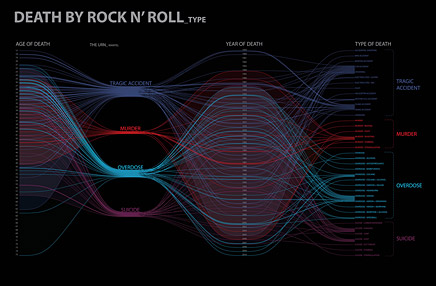
↑ Click image to enlarge
Death By Rock and Roll: Diagram
Death by Rock and Roll is an opportunity to reconceive the crematory urn on terms gleaned from the cultural practice of Rock and Roll. In our case, the urn takes on the role of noting the particular rituals of these heroes, (always stranger than fiction) and leverages them as drivers for a new expression altogether different from the conventional urn typology and practice.
A Retroactive Urn for Kurt Cobain
The urn for Kurt Cobain is not a singular vessel, nor will it simply hold his ashes in the conventional sense. Instead, a retroactive urn for Kurt Cobain will be made in multiple pieces, as a family of parts, and will be synthesized from his ashes. Composed as a series of geometric figures and made from his ashes suspended in a substrate, we imagine they will inspire new forms of sharing and distribution rituals enabled by their multiplicity.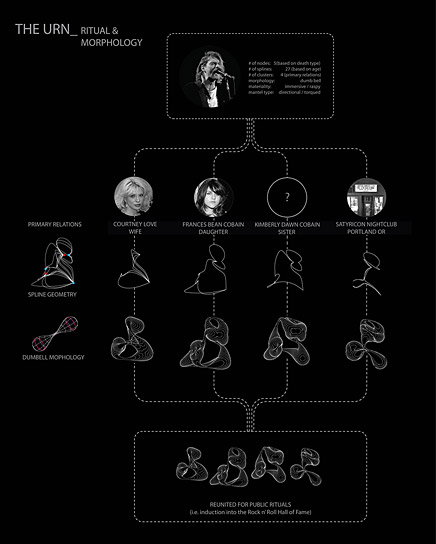
↑ Click image to enlarge
Death By Rock and Roll: Urn Morphology
One configuration (of the four) is to be kept by his surviving wife, Courtney Love. The second will rest in Portland's Satyricon Nightclub, where Courtney first met Cobain on January 12, 1990. Their daughter, Frances Bean Cobain will keep the third, and his sister Kimberly will keep the fourth. All four parts will eventually be reunited in the Rock and Roll Hall of Fame when he is (inevitably) inducted.
↑ Click image to enlarge
Death By Rock and Roll: Urn Mantle
The urn is not alone. Each configuration will rest on a custom fabricated mantel. The mantle transforms into a docking plane for the urn. It both receives the urn (by dimpling its surface) and provisionally nests at three particular points of contact. The contoured section of the mantel is derived from an extrusion of Kurt’s facial profile.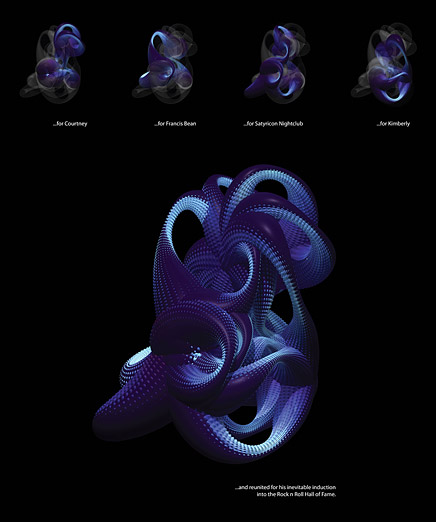
↑ Click image to enlarge
Death By Rock and Roll: Urn Family
Like a lost set piece from Jean Cocteau’s Beauty and the Beast , the (traditional) fireplace mantle is caught in a feral moment. While one end of the mantle dwells in a figurative reality, the other occupies a deep psychotropic trance, a time-space proper to the ecstasy and wonder of the Rock and Roll induced dream.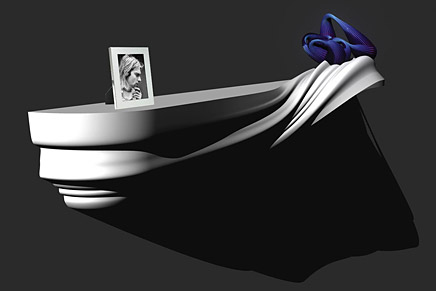
↑ Click image to enlarge
Death By Rock and Roll: Mantle & Urn
↑ Click image to enlarge
Death By Rock and Roll: Side Elevation X-Ray
↑ Click image to enlarge
Death By Rock and Roll: Front Elevation X-Ray
↑ Click image to enlarge
Death By Rock and Roll: Top View X-Ray
The urn is (in)formed by the prosaic aspects of Kurt's death (age:27, type: suicide) along with the unique characteristics of his musical persona (raspy voice, album cover art). These attributes are converted into the quantitative and qualitative aspects of the urn as an object. Just as rock and roll is a medium that counters main stream culture, the sinuous and unstable nature of the form serves as a counterpoint to the traditional urn type. Together, the size, weight, shape, color, and texture of the urn is intended to simultaneously deliver an immediate and visceral affect as well as sustain traditions of ritual associated with death.
Death by Rock and Roll: The Series
We envision a series of urns, some retroactive, but most for a future of rock stars not yet expired. While all of the urns would be of a family or genre (much like the music), each would be differentiated according to the qualities and particularities of its subject. The architecture of the urn would capture a cultural mood; much in the same way the musician does (did) with their music, combined with their individual persona. Ultimately we see the urn not only as a vessel commemorating the life of its subject, but also as representative of a larger cultural phenomenon and as an enabler of a cultural event to celebrate it.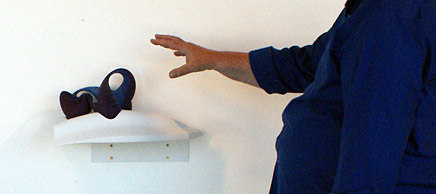
↑ Click image to enlarge
Death By Rock and Roll: Exhibition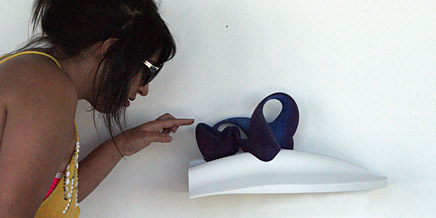
↑ Click image to enlarge
Death By Rock and Roll: Exhibition
↑ Click image to enlarge
Death By Rock and Roll: Exhibition
↑ Click image to enlarge
Death By Rock and Roll: Exhibition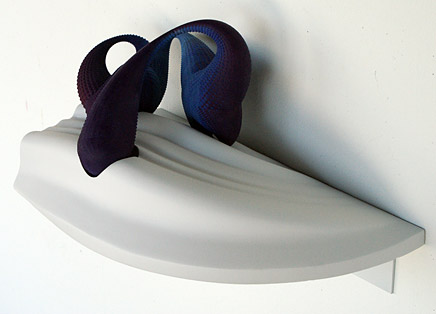
↑ Click image to enlarge
Death By Rock and Roll: Exhibition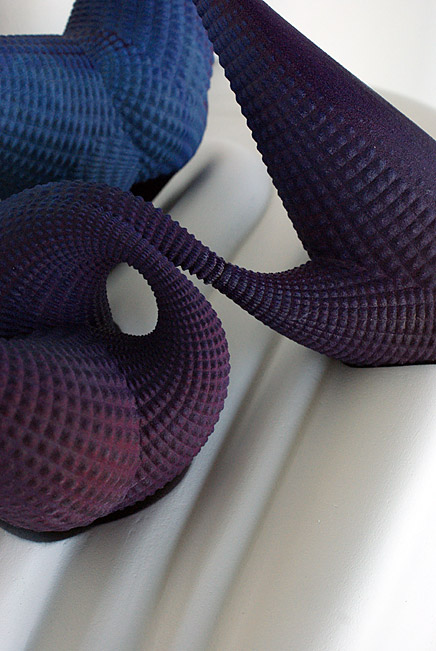
↑ Click image to enlarge
Death By Rock and Roll: Exhibition
Project Team: SCI-Arc Faculty Members Ramiro Diaz-Granados (Amorphis ), Heather Flood (F-lab ), and Eric Kahn & Russell Thomsen (IDEA Office ) collaborated for this exhibit work in Seattle.
Creative Commons License
This work is licensed under a Creative Commons License .
/Creative Commons License
8 Comments
OK, I have to admit my first reaction to the IDEA of the profile-mantel was that it's kind of hokey, but looking at the rendering and model it's actually very cool! It's subtly reminiscent of a face, for sure, AND it's not a skeuomorph, which makes it very attractive as a mantel. Nice work.
these graphics are pretty awesome
If they say their trying to be sympathetic to the person's persona, I personally I think they've got the aesthetic sensiblities wrong. If someone told me it was the urn of a dead musician, but didn't tell me which one, my first thought would be that it was for a techno artist or something. Having been a fan of Nirvana since In Utero came out, it was actually the first CD I ever bought, I personally don't think this digital aesthetic fits. Though, with the explaination perhaps they do convince me of the abstraction, but without, perhaps not.
It's a bit presumptuous to suggest that the urn is a representation of any face or the combination of 4, so I will consider the 4 faces simply as embodied difference. What is exceptional about this piece is that a formal typology (the naturalistic twisty, viney, growy, organic matter thing) that has consistently been rendered as appropriate to buildings has finally found its logical scale in the urn. The abstraction is appropriate as an urn is a representation of nothing in particular, it is merely a container for ashes which also represent nothing but are the actual remains of the deceased. To say that this particular urn is supposed to suggest anything other than the abstraction that is pervasive in rock n'roll is erroneous, but this its success. You can say whatever you want about it but at the end you can't touch its soul, if an urn had a soul, much like rock n'roll. So neither the single object nor the content is the representation, the suggestion of the interaction with the object is the representational moment.
The irony is that these "architects" would like to think of themselves as rock stars. The only thing being housed in this urn is the hours of wasted time, effort and archi-speak and yet another useless demonstration of blob-based design.
Seriously guys, like Cobains death, it's time to move on.
not "cool", it's a hot mess. one part however, can be salvaged. the ghost face is actually pretty good.
Wasted talent.....is the theme here but I don't think the authors understand the irony of it all.
Friend mentioned her best misunderstood lyric:
Here we are now
In containers
Haha. Death is funny.
Block this user
Are you sure you want to block this user and hide all related comments throughout the site?
Archinect
This is your first comment on Archinect. Your comment will be visible once approved.